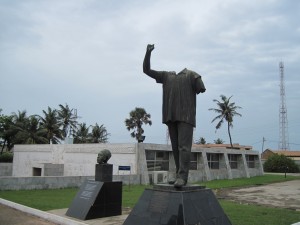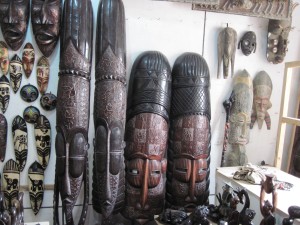What do most Americans know or think they know about Africa? A number of stereotypes come to mind. African countries are unsafe and unhealthy, always at war, unstable, and poor. People are uneducated and lazy, and live in rural villages among wild animals. But there are 54 countries with an incredible variety of conditions. There are civil wars and coups, but many countries are very stable. Only about half the population lives in rural areas. Wild animals are now mostly confined to parks and reserves. Many countries have significant middle classes. I spent most of my academic career helping people become more knowledgeable. This article attempts to provide some perspective about African history, politics, and current affairs, with some attention to Ghana.
The mechanisms of neo-colonialism. In order to halt foreign interference in the affairs of developing countries it is necessary to study, understand, expose and actively combat neo-colonialism in whatever guise it may appear. For the methods of neo-colonialists are subtle and varied. They operate not only in the economic field, but also in the political, religious, ideological and cultural spheres. Faced with the militant peoples of the ex-colonial territories in Asia, Africa, the Caribbean and Latin America, imperialism simply switches tactics. Without a qualm it dispenses with its flags, and even with certain of its more hated expatriate officials. This means, so it claims, that it is ‘giving’ independence to its former subjects, to be followed by ‘aid’ for their development. Under cover of such phrases, however, it devises innumerable ways to accomplish objectives formerly achieved by naked colonialism. It is this sum total of these modern attempts to perpetuate colonialism while at the same time talking about ‘freedom’, which has come to be known as neo-colonialism. Foremost among the neo-colonialists is the United States, which has long exercised its power in Latin America. Fumblingly at first she turned towards Europe, and then with more certainty after world war two when most countries of that continent were indebted to her. Since then, with methodical thoroughness and touching attention to detail, the Pentagon set about consolidating its ascendancy, evidence of which can be seen all around the world. From Kwame Nkrumah, Neo-Colonialism, the Last Stage of imperialism, 1965.
Decolonization and Socialism
With some exceptions (Egypt, Ethiopia, and Liberia), most African countries won their independence from the French and British colonial empires in the 1950s and the first half of the 1960s. Some fought liberation wars, and others benefited by a peaceful transfer of power because of their neighbors’ sacrifices. The Portuguese colonies of Angola, Mozambique, Guinea-Bissau, Cape Verde, and São Tomé and Príncipe won independence in 1975. Zimbabwe followed in 1980, Namibia in 1990, and South Africa won majority rule only in 1994. Perhaps half of these states adopted ideologies and government structures based on some form of “socialism,” a term with a wide variety of meanings in various places and contexts throughout the world. The term “African Socialism” encompassed, for example: Kenneth Kaunda’s vague “humanism” in Zambia, Muammar al-Qadhafi’s Jamahiriya (“state of the masses”) in Libya, Julius Nyerere’s Ujamaa (“familyhood”) in Tanzania, and Leopold Senghor’s Négritude in Senegal. Other countries adopted a more Marxist or Marxist-Leninist orientation, such as Kwame Nkrumah’s Consciencism in Ghana, and revolutionary governments in Angola, Mozambique and Zimbabwe. Many included a strong emphasis on Pan-Africanism, the idea that Africa must unite to reach its true potential. Pan-Africanism includes people of African descent, especially people in North America, the Caribbean, and parts of South America descended from enslaved Africans.
Political Experiments
As an undergraduate student in the late 1960s, I became fascinated with the independence struggles and political experimentation in the new states. It was a time of political ferment in the US, and young people like myself were looking for alternative ideas and models. We saw that capitalism fostered racism and war. Similarly, many African countries rejected the political systems of their capitalist colonizers, and adopted alternatives based on some notion of socialism. The Cold War between the West, Soviet Union, and China also played a role. Most African countries joined the Nonaligned Movement, but all took aid and assistance from one side or the other, and in some cases all sides at the same time in order to balance these influences. For example, Tanzania managed to get the US to build its main north-south road while China built a parallel railroad. The Scandinavian countries also provided much material assistance. Liberation movements in countries still fighting for their independence often received material aid and weapons from the Soviet Union or China, the most logical places to find assistance against the Western imperial powers. In some cases as in Zimbabwe, rival liberation movements were aided by either China or the Soviet Union within the same country.
The Failure of Socialist Models
But declaring socialist models and successfully implementing such development were two different things. African countries were “underdeveloped,” meaning that the imperial powers had systematically exploited African people and resources in order to make themselves rich. Africans did not have the means to accomplish their goals, and new elites were often more concerned with enriching themselves than national development. Countries had to turn to benefactors in the East or West, as well as the International Monetary Fund and the World Bank. The disintegration of the Soviet Union left countries and movements no alternative to capitalism. Fine rhetoric about democracy and equality often turned into corruption and despotic rule, as well as dependence on former colonial powers. Furthermore, the World Bank mandated Economic Structural Adjustment Programs that only made conditions worse. In effect, all these countries eventually became thoroughly integrated into the world capitalist system.
“I would like to show how we are changing lives.” Ghanaian President John Dramani Mahana, State of the Union Address, February 25, 2016
Ghana
Gold Coast colony became Ghana with its independence from Britain in 1957, the first in the wave of decolonization south of the Sahara after World War II. Its first President was Kwame Nkrumah, a prominent visionary socialist with a Pan-Africanist agenda. He envisioned a democratic and prosperous United States of Africa. Although his government accomplished much, socialist development was overturned by a coup in 1966.
I recently travelled to the country to learn more about the history of the transatlantic slave trade and see for myself how things are going. The slave trade was organized from numerous European castles along the West African coast. These castles represent the first European-built and -occupied spaces on the continent. They were originally fortresses and trading posts, but soon included dungeons to house captive Africans, churches, and the offices and living quarters of colonial rulers. About 6.5 million enslaved people were forcefully transferred in the most horrific conditions from just the Gold Coast slave castles to the Western Hemisphere. Many African Americans traveled to Ghana after independence, and some stayed. W. E. B. DuBois is perhaps the most famous African-American scholar who settled in Ghana (at age 93!). As an activist and socialist, DuBois was a pioneer in researching African history. Nkrumah had invited him to attend the independence celebrations in 1957, but the US had confiscated his passport at that time. About 65,000 Americans visited Ghana last year, and about one-third of them were African Americans on an emotional quest to reconnect to an unknown ancestral homeland. There are several thousand African Americans living in the country today.
Ghana is now a multi-party democracy, with a high degree of freedom of speech and press. It is classified as medium in the UN Human Development Index. It is designated as medium for inequality, has a fast-growing middle class, and is ranked as a “lower middle income” country by the World Bank. The party in power, the National Democratic Congress (NDC), defines itself as social democratic. The New Patriotic Party (NPP), the main opposition, has a liberal capitalist orientation. Interestingly, one Ghanaian told me he thought that the policies of the NPP when they were in power were actually more social democratic than the policies of the current government. The socialist Convention People’s Party, Nkrumah’s party, was revived in 1996, but has only one seat in the current Parliament. The next presidential and parliamentary elections will take place on November 7, 2016.
Travelling in Ghana is fascinating and fun. It is sobering to tour the slave castles, interesting to see DuBois’ house and library, and educational to visit museums explaining various ethnic groups. The food is tasty and delicious, and Ghana is known for its beautiful Adinkra and Kente cloth, and expressive woodcarvings. Contemporary Ghana shatters all the stereotypes noted above.
Amazingly for grey-haired folks like myself, recent US polls show that around half of people under 40 now have a positive view of socialism. Perhaps we need to experiment more, just as African countries tried to do half a century ago. And significant progressive change in the US might provide new possibilities for countries around the world.
Al Kagan is African Studies Bibliographer and Professor of Library Administration Emeritus from the University of Illinois.




